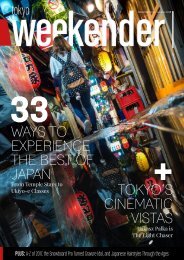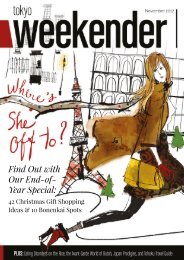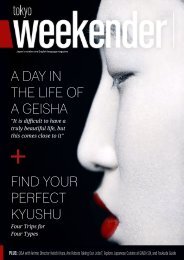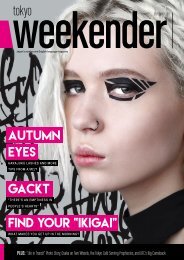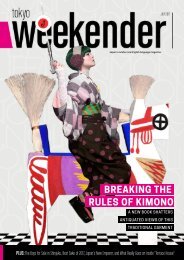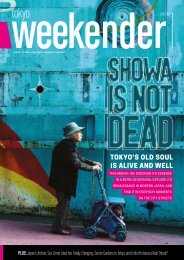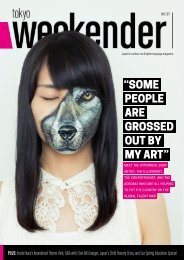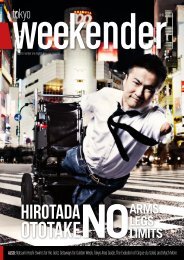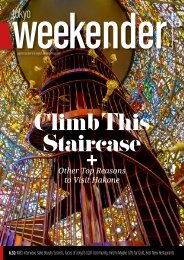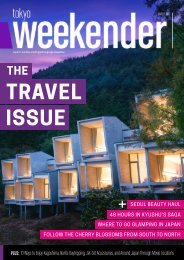Tokyo Weekender - February 2016
Hidetoshi Nakata a soccer all-star on the sake trail. The Tokyo Marathon turns ten. Scaling Japan’s frozen heights.
Hidetoshi Nakata a soccer all-star on the sake trail. The Tokyo Marathon turns ten. Scaling Japan’s frozen heights.
Create successful ePaper yourself
Turn your PDF publications into a flip-book with our unique Google optimized e-Paper software.
GALLERY GUIDE<br />
TOKYO GALLERY GUIDE<br />
OUR PICKS FROM THE EXHIBITIONS AROUND TOWN<br />
by Luca Eandi<br />
HARA DOCUMENTS 10: Masaharu Sato—<strong>Tokyo</strong> Trace<br />
The “Hara Documents”<br />
series was launched<br />
in 1992 to promote<br />
emerging artists. The<br />
tenth installment<br />
features Masaharu Sato’s newest<br />
work, “<strong>Tokyo</strong> Trace.” In it, Sato<br />
presents a number of vignettes<br />
of present-day <strong>Tokyo</strong> which he<br />
reworks using a technique he<br />
calls “shadowing.”<br />
This process that Sato developed<br />
is based on the meticulous<br />
tracing of actual video stills. He<br />
uses a camera to shoot ordinary<br />
scenes of people and landscapes<br />
and then augments them with a<br />
digital pen. His goal is to “get as<br />
close to the video image as possible<br />
by emphasizing nothing and<br />
leaving no trace of pen behind.”<br />
The immense time and labor, the<br />
repetitive tracing of prosaic<br />
scenes, the production of hundreds<br />
of frames that comprise<br />
the animation—this seemingly<br />
extraneous process is one that<br />
produces the subtle skewed<br />
reality that makes Sato’s work<br />
special. Viewers experience a<br />
momentary feeling of puzzlement,<br />
sensing something amiss<br />
in the apparently ordinary<br />
scene.<br />
His 2014 work, titled “Calling,”<br />
created after the strife<br />
of living through the Great<br />
East Japan Earthquake and<br />
consecutive bouts of illness<br />
experienced by himself and<br />
another member of his family<br />
also makes up the exhibition,<br />
as well as newly-created<br />
two-dimensional art.<br />
Bye bye come on, 2010, animation, loop, single-channel video<br />
Hara Museum of Contemporary Art<br />
Dates: January 23–May 8, <strong>2016</strong><br />
Open: 11:00 am–5:00 pm, 11:00 am–8:00 pm on Wednesdays, closed<br />
Mondays (except March 21) and March 22, last admission 30 minutes<br />
before closing | Web: www.haramuseum.or.jp<br />
VISIT JAPAN: Tourism Promotion in the 1920s and 1930s<br />
Left: MACHIDA Ryuyou, Osaka Shosen Kaisha (Yokozuna Tachiyama), c.1917 Hakodate City<br />
Central Library Right: Pieter I. Brown, Japan (Night scene at a shrine), 1934 Private collection<br />
The National Museum of Modern Art, <strong>Tokyo</strong><br />
Dates: January 9–<strong>February</strong> 28, <strong>2016</strong> | Open: 10:00 am–5:00 pm, 10:00<br />
am–8:00 pm on Fridays, last admission 30 minutes before closing<br />
Web: www.momat.go.jp<br />
It was reported in January<br />
that Japan (nearly)<br />
reached its goal of drawing<br />
20 million visitors in 2015,<br />
a full five years ahead of<br />
the original 2020 target. Impressively,<br />
that figure nearly quadruples<br />
the 5.2 million people that<br />
visited Japan when the current<br />
government-sponsored tourism<br />
campaign kicked off in 2003. A<br />
true feat, considering the country<br />
was closed to tourism until the<br />
late 1880s, so Japan was relatively<br />
unaccustomed to promoting its<br />
attractions to the rest of the world<br />
until the early 20th century.<br />
Now, ahead of the 2020<br />
Olympics, The National Museum<br />
of Modern Art, <strong>Tokyo</strong>, is looking<br />
back at advertisements that were<br />
used to promote Japan in one of<br />
the country’s earliest promotional<br />
campaigns during the 1920s<br />
and ‘30s. This era saw improved<br />
modes of commercial aviation,<br />
encouraging leisure travel to<br />
Japan. The government had consciously<br />
spent the previous two<br />
decades bolstering its railway<br />
and hotel networks.<br />
The exhibition features<br />
posters, pictorial magazines and<br />
travel brochures from the time.<br />
Designed by well known names<br />
such as Hisui Sugiura, Yumeji<br />
Takehisa, Hatsusaburo Yoshida<br />
and Munetsugu Satomi, the<br />
posters involve motifs that include<br />
kimonos, sumo wrestlers,<br />
cherry blossoms and Mount<br />
Fuji—symbols now synonymous<br />
with the land. If you’re looking<br />
to save some money on this<br />
exhibition, admission is free on<br />
<strong>February</strong> 7.<br />
FEBRUARY <strong>2016</strong> www.tokyoweekender.com



